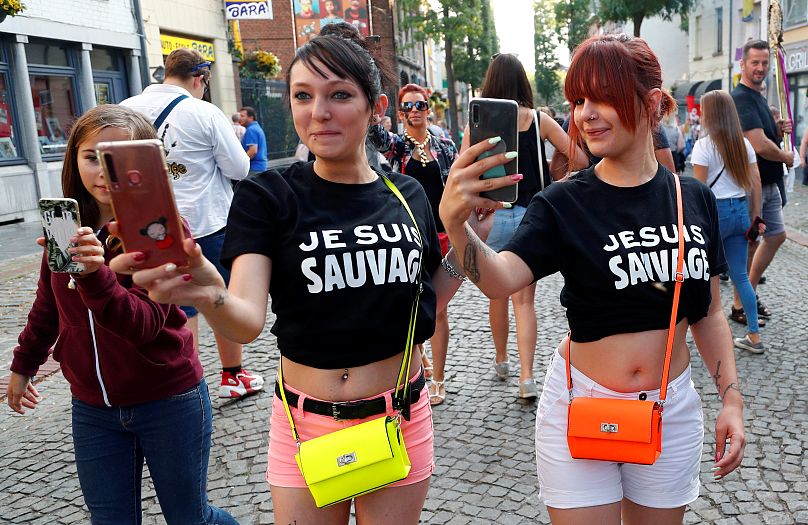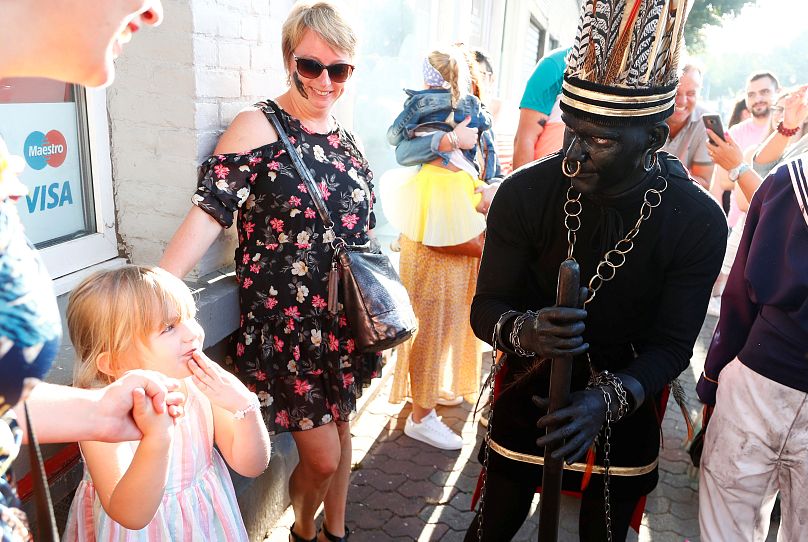Anti-racism campaigners have criticised a folk festival featuring a character called "the savage". The character, played by a white actor in blackface makeup, is paraded through the town in chains.
Blackface makeup is back in the spotlight in Belgium, as anti-racism campaigners have criticised a folk festival held on Sunday in the Wallonian city of Ath for featuring a character called "the Savage" (le Sauvage).
The character, played by a white actor in blackface makeup, is paraded through the town in chains, screaming and scaring children, before being shackled to a float made to look like a boat manned by sailors.
Mouhad Reghif of Belgian anti-racism group Brussels Panthers, which launched a petition in early August against the inclusion of le Sauvage at the annual event, said the character constitutes a "degrading" image of black people and perpetrates discrimination as a result.
He said: "This character has a wild attitude and behaviour. He's shouting at people. He scares children. I have a black friend living in Ath. In the past, she met a child who started crying because she reminded him of 'the Savage'."
The mayor of Ath, Bruno Lefebvre, has defended le Sauvage, saying criticism of the event comes only from those outside the town. "At Ath, we never considered 'the savage' to be a racist figure. It is rather a character that the inhabitants of Ath adulate. After all, when one gets a kiss from 'the Savage' we get lucky all the year ahead.
"This is the nice side of face-painting, since the black paint must be passed on to the people of Ath throughout the procession. Therefore we are really in a dynamic that has nothing to do with racism or negrophobia," he added.
Festival spectator and Ath local Dominique Hendrickx agreed with Lefebvre, saying: "It's part of the parade. If it is not in Ath, it will be another part of the folklore that will be pointed out. For me, there is no polemic to raise.
"Myself, I was born in Zaire, formerly Belgian Congo. My neighbours are African and I have no problem with that. And I think no inhabitant of Ath has any problem with that."
Myriam Carlier, another attendee, echoed this, saying: "I think it's our folklore, our tradition and I'm in favour of the Savage."
For Reghif, however, the Savage remains problematic, however he is intended to be perceived. "What we ask Ath people is to understand that even if they have no racist intention – and we do believe them – this character helps [in] retaining negrophobia and thus takes part in a form of structural discrimination experienced by Afro-descendant and black people. "
During this year's parade, "the Savage" gave his chains to the mayor, reportedly to quell debate about the issue.
In the Belgian capital Brussels, the Royal Museum for Central Africa found itself the subject of blackface controversy earlier this month when guests at an Africa-themed party held in the museum grounds (organised by an unaffiliated events company named Thé Dansant) wore colonial-themed costumes, with one pictured in blackface makeup.
The museum – located in the Brussels suburb of Tervuren, close to the site where in 1897 a "human zoo" of Congolese men, women and children was set up on the orders of King Leopold – had previously housed controversial exhibits, criticised as "colonialist" and "imperialist' in nature, prior to its five-year closure for a €75 million renovation and “decolonisation” in 2013.
Displays at the museum, which houses one of the world's largest collections of African art, presented an overwhelmingly positive view of Belgium's colonial past – the country controlled the Belgian Congo (now Democratic Republic of Congo) from 1908 to 1960, and Ruanda-Urundi (now the two countries of Rwanda and Burundi) from 1922 to 1962 – and a racist, paternalistic view of the indigenous populations, who were portrayed as primitive. Statues on display included black children clinging to a white missionary and topless African women dancing, and had names such as “Belgium Brings Civilisation to Congo”.
The museum's reopening, despite the overhaul of its displays, change in tone in its information cards, and the inclusion of contemporary African art, sparked further protest, with the president of the Democratic Republic of Congo (DRC) Joseph Kabila demanding that the country's stolen artefacts be returned.
Activist group Cafe Congo, which focuses on Belgo-Congolese relations, posted criticism of the party held this month at the museum on Facebook, writing: "Explain to me how this kind of event still exists in 2019 at the Africa Museum? Is the administration or its communications team on Xanax?"
The museum apologised in an Instagram post, saying that it had asked the event organiser to change the dress code but that "this measure turned out to be insufficient as some of the participants still chose to wear stereotypical outfits".
Thé Dansant, also posting on social media, said it regretted that "that some people felt upset about some images that appeared after the event" and pointed out that half the DJs at the party were of African origin.
The use of the Zwarte Piet (Black Peter) character in Christmas parades in both Belgium and the Netherlands has also attracted criticism in recent years. The character, who is a Moor from Spain, is the companion of Saint Nicholas, handing out sweets and presents at school, shopping centres and parades.
He is traditionally portrayed using blackface makeup, a curly black wig and red lipstick, although in recent years many Dutch schools and businesses have opted to either alter his appearance, or abandon the character altogether. However, figures show a large majority of the public in both Belgium and the Netherlands remain in favour of retaining the character in his traditional iteration.
So are events such as Christmas parades and the Ducasse d'Ath festival preserving traditions or propagating racist stereotypes? Opinions are staunchly defended on either side – one more division in a country rife with them, carved up along linguistic and cultural lines – but the question is more pertinent than ever as Belgium continues to battle its colonial hangover.













